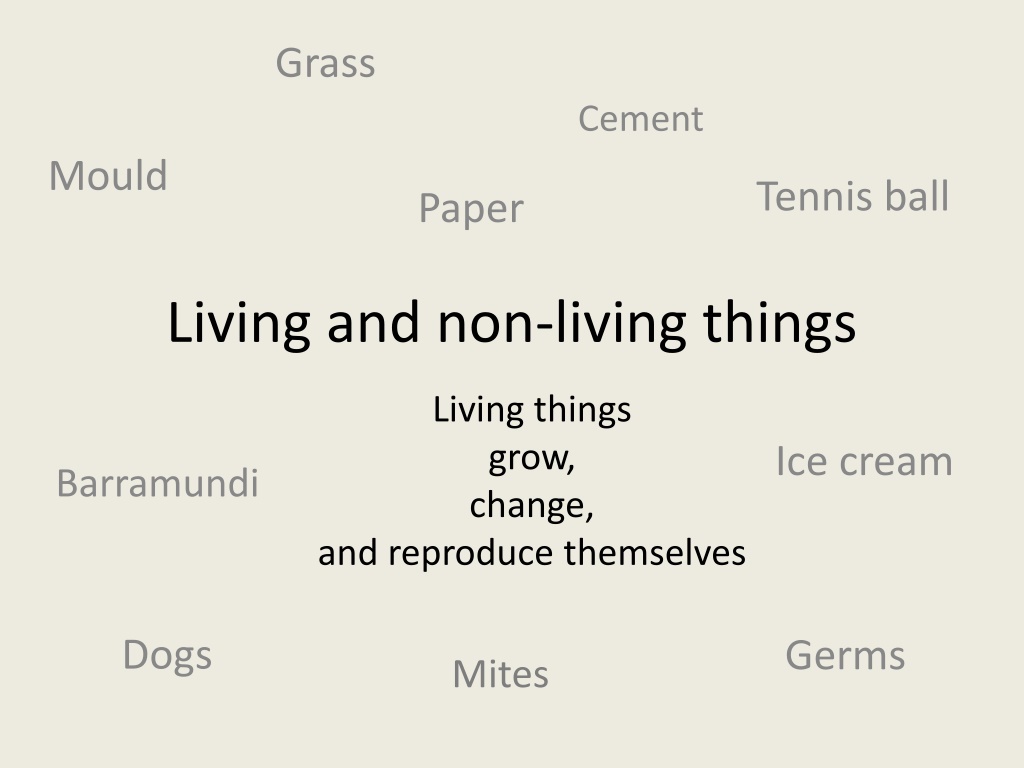Exploring Living and Non-Living Things Through Images
Discover the diversity of living and non-living entities, from grass and mould to dogs and mites, with explanations on growth, reproduction, and more. Dive into the microscopic world of mites and learn about different types of mange affecting dogs.
Download Presentation

Please find below an Image/Link to download the presentation.
The content on the website is provided AS IS for your information and personal use only. It may not be sold, licensed, or shared on other websites without obtaining consent from the author. Download presentation by click this link. If you encounter any issues during the download, it is possible that the publisher has removed the file from their server.
E N D
Presentation Transcript
Grass Cement Mould Tennis ball Paper Living and non-living things Living things grow, change, Ice cream Barramundi and reproduce themselves Dogs Germs Mites
Barramundi Mould Grass Living and Growing Dogs Mites Germs Living things grow, change, and reproduce themselves
Living and Growing Dogs Mites Germs
Just like all mammals, dogs need a male and female to make puppies.
Girls dogs can have puppies from 6 months old
Girl dogs can have two litters of puppies every year. Click on the screen to see what that looks like
Living and Growing Dogs Mites Germs
What are Mites? Mites are like little animals, like little ticks, but much smaller. Scabies mites can cause scabies.
This is a mite . She is very small.
This is a mite. . She is very small. Let s use a magnifying glass to make her bigger.
This is a mite. . We can just see her! Let s look closer under a microscope.
Mange mite Demodex
Mange mite Demodex
Mange mite Sarcoptes
How does Mange spread in Dogs?
Mites can cause mange in dogs, and make people itchy too.
Adult mites lay eggs This life cycle takes about 1 month. The baby mites grow up into adult mites. The eggs hatch, and more mites come out. Mange mite Sarcoptes
Mites live in the skin. They make a dog itchy so they loose their hair.
Mites make tunnels, crawling around under the skin.
How does mange spread in dogs? Mange crawl using their legs
One dog spreads mange to others Treating some dogs doesn t stop the problem The drug wears offs and the mites crawl back on
The mange medicine kills the mites but doesn t kill the eggs
The mange medicine kills the mites but doesn t kill the eggs
The eggs will hatch making more mites
So we need to get rid of the eggs before they hatch Or use the mange medicine again
How can we get rid of eggs?
We can get rid of eggs by cleaning out our houses and washing all the blankets
Mites also dont like the sun, so getting lots of sunlight on things like mattresses will help control them
How to treat dogs for mange mites Mange mite has left the dog with sores and missing hair Treating the dog for mange mite Treated dog with all it s hair. Ivermectin or any other anti parasite medicine can be use to kill the mites. Place this on a piece of bread with meat paste. The dog eats the bread with medicine. A dog may need several treatments if mange is bad
How do dogs spread Scabies to Humans Scabies mites spread from dogs onto bedding. The scabies mites can jump from dogs or infected bedding onto people. The scabies mite can make people itch for a few weeks. The scabies mite can make the family itchy. If you have any itchy sore s you need to go to the clinic.
If we dont get treated for Scabies what happens? The skin becomes itchy. The itching causes open sores. The open sore becomes infected and bacteria gets into the sore. The open sores get infected with the Streptococcal Bacteria. Strep leads to Rheumatic Fever and damages the kidney a heart.
Living and Growing Dogs Mites Germs
This is Mr Germ He is very, very small.
This is Mr Germ He is very, very small. Let s use a magnifying glass to make him bigger
This is Mr Germ He s still too small to see! We ll need a microscope.
This is Mr Germ under a microscope. How is he moving?
19 - 18 - 17 - 16 - 15 - 14 - 13 - 12 - 11 - 10 - 9 - 8 - 7 - 6 - 5 - 4 - 3 - 2 - 1 - Let s make a graph to see how fast germs reproduce. On the side we can measure how many germs we have. On the bottom we measure how much time has gone by. I I I I I I I I I I I I I I I I I I I I I I I 5 10 15 20 25 30 35 40 45 50 55 60 65 70 75 80 85 90 95 100 105 110
19 - 18 - 17 - 16 - 15 - 14 - 13 - 12 - 11 - 10 - 9 - 8 - 7 - 6 - 5 - 4 - 3 - 2 - 1 - What do you think the graph will look like? Let s find out Then like this? Or maybe like this? Let s find out Like this? That would mean there are less germs as time goes on. I I I I I I I I I I I I I I I I I I I I I I I 5 10 15 20 25 30 35 40 45 50 55 60 65 70 75 80 85 90 95 100 105 110 Time (s)
19 - 18 - 17 - 16 - 15 - 14 - 13 - 12 - 11 - 10 - 9 - 8 - 7 - 6 - 5 - 4 - 3 - 2 - 1 - First get a big ball of plasticine to represent Mr Germ. Plasticine isn t alive, so it won t grow, but it splits just the same way. I I I I I I I I I I I I I I I I I I I I I I I 5 10 15 20 25 30 35 40 45 50 55 60 65 70 75 80 85 90 95 100 105 110 Time (s)























